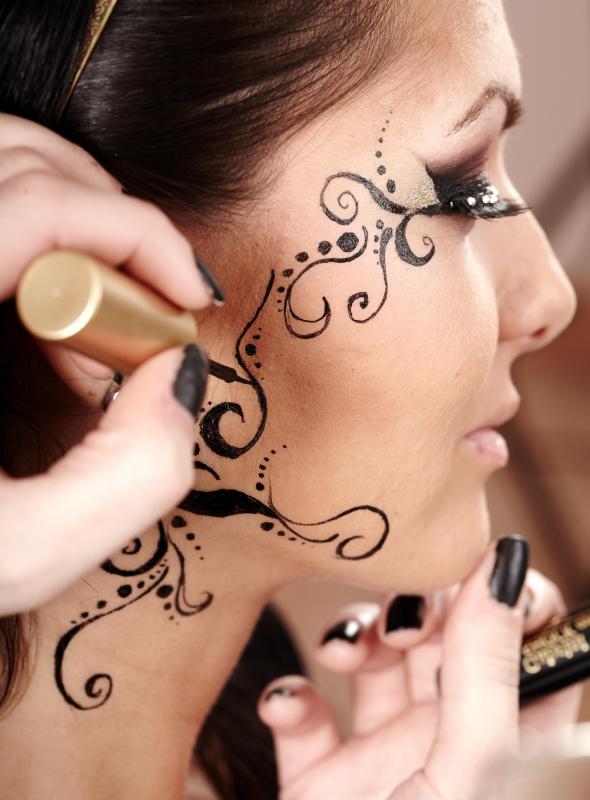At TheHealthBoard, we're committed to delivering accurate, trustworthy information. Our expert-authored content is rigorously fact-checked and sourced from credible authorities. Discover how we uphold the highest standards in providing you with reliable knowledge.
What is Black Henna?
Black Henna is made by mixing para-phenylenediamine (PPD) with henna, a natural, plant based dye. Although henna has been used for centuries to create temporary body art and tattoos, the black type is a modern creation. Pure henna is made from the henna plant, Lawsonia inermis, and is a safe, gentle means of dying one’s hair or skin. PPD is a chemical dye that is used in a range of products, including hair dye, dyes for fabrics and fur, printer and copier dyes, and photo developing chemicals. While henna is a natural product, PPD on the other hand, is listed by the Centers for Disease Control (CDC) as a contact allergen, and is a highly sensitizing substance, meaning most people will have some sort of an allergic reaction when they come in contact with it.
The Black Henna of modern times is different from that of the 19th century. This was a dye used to color hair black, which used a combination of indigo and henna. It is important to note that there is no such thing as naturally occurring black henna. Technically, even pure henna is illegal in the United States for use on the body to create body art, because the Food and Drug Administration (FDA) has never approved it for use on the skin. Regardless, use of henna for temporary tattoos is widespread, even in the United States, and the restriction is leniently enforced.

The benefit of adding PPD to henna is that it allows the tattoo artist to create a jet black tattoo, which is stained into the skin in as little as 30 minutes. Using pure henna is a more lengthy process, which results in lighter, brown stains. Black henna tattoos have become popular with tattoo artists in resort areas due to the fast, dramatic results as well as their high profit margin. Because the use of PPD in henna is not regulated, the concentration of the PPD added can vary drastically, and be well above what is approved for use in hair dyes.

Within days, black henna can cause extreme allergic reactions resulting in a red, blistering, itchy rash, and/or a chemical-like burn which may scab over and scar in the shape of the tattoo. Unfortunately, this substance may also result in a permanent PPD sensitivity. Those who have experienced an allergic reaction to the PPD in Black Henna may not be able to use hair dye, sunscreen, makeup or dark clothing that has the chemical. The PPD may also be a carcinogen, and has been linked to asthma.

If you or someone you know is considering a henna tattoo, there are ways to check if the dye used is pure henna. The powder used to make the henna paste, as well as the paste itself, should be green. If it is a very dark brown or black, and/or has a chemical smell, it may be black henna.
AS FEATURED ON:
AS FEATURED ON:
















Discussion Comments
to reply to post number 2 anon60516: Fully oxidized is not a sensitizer is meant as you cannot become allergic from the fully oxidized form of it, i.e. black clothing, or the black rubber handlebars on your bike.
But if you already have the allergy and have also become sensitized to PPD, then you can also get reactions from its fully oxidized forms.
Jody Jean 0821: If your friend develops reactions in the shape and location of the tattoo (this can be weeks afterwards) he can still be at risk. And the only way that might get the stain out is bleaching, it's basically the same stuff they use to dye clothes with.
i recently had a black henna tattoo without knowing the side effects and that what i was getting wasn't "pure henna". i haven't had any allergic reactions.. does this mean I'm not allergic and can continue to use black henna?
First of all, thank you so much for this article. I recently had a "black henna" tattoo done and had a horrible reaction to it.
Your article mentions that someone sensitised to it may also be sensitised even to black clothing. However a related article on your website titled "What-is-para-phenylenediamine-ppd" states that fully oxidised PPD is not a sensitizer. I would have thought that the PPD in black clothing etc would have been fully oxidised. Can someone please help as I am confused and worried! Thank you.
Help!!! I was recently on vacation & my friend decided to get a henna tattoo, which turned out to be a black henna tattoo, and some got on my favorite shirt. Health concerns aside, I need to know if there is a way to get this stain out!!! Please help if you can!
Post your comments